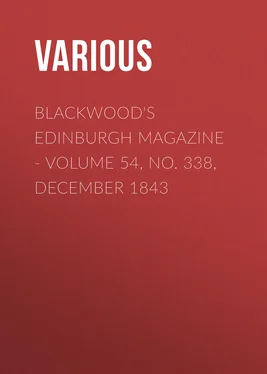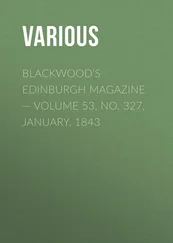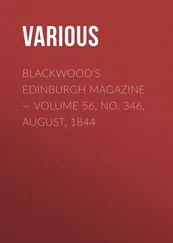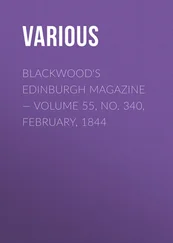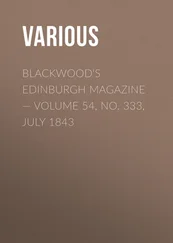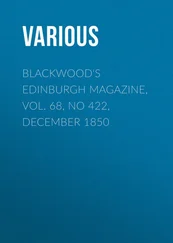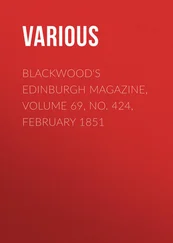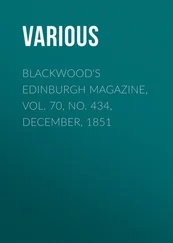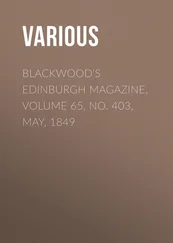Various - Blackwood's Edinburgh Magazine - Volume 54, No. 338, December 1843
Здесь есть возможность читать онлайн «Various - Blackwood's Edinburgh Magazine - Volume 54, No. 338, December 1843» — ознакомительный отрывок электронной книги совершенно бесплатно, а после прочтения отрывка купить полную версию. В некоторых случаях можно слушать аудио, скачать через торрент в формате fb2 и присутствует краткое содержание. Издательство: Иностранный паблик, Жанр: foreign_antique, periodic, foreign_edu, на английском языке. Описание произведения, (предисловие) а так же отзывы посетителей доступны на портале библиотеки ЛибКат.
- Название:Blackwood's Edinburgh Magazine - Volume 54, No. 338, December 1843
- Автор:
- Издательство:Иностранный паблик
- Жанр:
- Год:неизвестен
- ISBN:нет данных
- Рейтинг книги:3 / 5. Голосов: 1
-
Избранное:Добавить в избранное
- Отзывы:
-
Ваша оценка:
- 60
- 1
- 2
- 3
- 4
- 5
Blackwood's Edinburgh Magazine - Volume 54, No. 338, December 1843: краткое содержание, описание и аннотация
Предлагаем к чтению аннотацию, описание, краткое содержание или предисловие (зависит от того, что написал сам автор книги «Blackwood's Edinburgh Magazine - Volume 54, No. 338, December 1843»). Если вы не нашли необходимую информацию о книге — напишите в комментариях, мы постараемся отыскать её.
Blackwood's Edinburgh Magazine - Volume 54, No. 338, December 1843 — читать онлайн ознакомительный отрывок
Ниже представлен текст книги, разбитый по страницам. Система сохранения места последней прочитанной страницы, позволяет с удобством читать онлайн бесплатно книгу «Blackwood's Edinburgh Magazine - Volume 54, No. 338, December 1843», без необходимости каждый раз заново искать на чём Вы остановились. Поставьте закладку, и сможете в любой момент перейти на страницу, на которой закончили чтение.
Интервал:
Закладка:
"Sublimity of conception, grandeur of form, and breadth of manner, are the elements of Michael Angelo's style. By these principles, he selected or rejected the objects of imitation. As painter, as sculptor, as architect, he attempted—and above any other man, succeeded—to unite magnificence of plan, and endless variety of subordinate parts, with the utmost simplicity and breadth. His line is uniformly grand. Character and beauty were admitted only as far as they could be made subservient to grandeur. The child, the female, meanness, deformity, were by him indiscriminately stamped with grandeur. A beggar rose from his hand the patriarch of poverty; the hump of his dwarf is impressed with dignity; his women are moulds of generation, his infants teem with man; his men are a race of giants. This is the 'terribile via' hinted at by Agostino Caracci; though, perhaps, as little understood by the Bolognese as by the blindest of his Tuscan adorers, with Vasari at their head. To give the appearance of perfect ease to the most perplexing difficulty, was the exclusive power of Michael Angelo. He is the inventor of epic in painting, in that sublime circle of the Sistine chapel which exhibits the origin, the progress, and the final dispensations of theocracy. He has personated motion in the groups of the cartoon of Pisa; embodied sentiment on the monuments of St Lorenzo; unraveled the features of meditation in the prophets and sibyls of the Sistine chapel; and in the 'Last Judgment,' with every attitude that varies the human body, traced the master trait of every passion that sways the human heart. Though, as sculptor, he expressed the character of flesh more perfectly than all who went before or came after him, yet he never submitted to copy an individual—Julio the Second only excepted; and in him he represented the reigning passion rather than the man. In painting, he contented himself with a negative colour, and as the painter of mankind, rejected all meretricious ornament. The fabric of St Peter's scattered into infinity of jarring parts by Bramante and his successors, he concentrated; suspended the cupola, and to the most complex, gave the air of the most simple of edifices. Such, take him for all in all, was Michael Angelo, the salt of art; sometimes, no doubt, he had his moments of dereliction, deviated into manner, or perplexed the grandeur of his forms with futile and ostentatious anatomy; both met with armies of copyists, and it has been his fate to have been censured for their folly." This studied panegyric is nevertheless vigorous—emulous as that of Longinus, of showing the author to be—
"Himself, the great sublime he draws."
It hurries away the mind of the reader till it kindles a congenial enthusiasm, we have the more readily given the quotation, as it is not an unfair specimen of Mr Fuseli's power, both of thought and language. Our author is scarcely less eloquent in his eulogy of Raffaelle which follows. He has seized on the points of character of that great painter very happily. "His composition always hastens to the most necessary point as its centre, and from that disseminates, to that leads back, as rays, all secondary ones. Group, form, and contrast are subordinate to the event, and common-place ever excluded. His expression, in strict unison with, and inspired by character; whether calm, agitated, convulsed, or absorbed by the inspiring passion, unmixed and pure, never contradicts its cause, equally remote from tameness and grimace: the moment of his choice never suffers the action to stagnate or expire; it is the moment of transition, the crisis, big with the past, and pregnant with the future."
It is certainly true—the moment generally chosen by Raffaelle, is not of the action completed, the end—but that in which it is doing. You instantly acknowledge the power, while your curiosity is not quenched. For instance, in the cartoon of the "Beautiful Gate," you see the action at the word is just breaking into the miracle—the cripple is yet in his distorted infirmity—but you see near him grace and activity of limb beautifully displayed, in that mother and running child; and you look to the perfection which, you feel sure, the miracle will complete. This is by no means the best instance—it is the case in all his compositions where a story is to be told. It is this action which, united with most perfect character and expression, makes the life of Raffaelle's pictures. We think, however, that even in so summary a history of art as this, the object of which seems to be to mark the steps to its perfection, the influence of Pietro Perugino should not have been omitted. He is often very pure in sentiment, often more than bordering on grace, and in colour perhaps superior to Raffaelle. Notwithstanding Mr Fuseli's eulogy of Raffaelle, we doubt if he fully entered into his highest sentiment. This we may show when we comment on another lecture. While Rome and Tuscany were thus fostering the higher principles of art, the fascination of colour was spreading a new charm to every eye at Venice, from the pencils of Giorgione, and of Titian. Had not Titian been a colourist, his genius was not unequal to the great style; perhaps he has admitted of that style as much as would suit the predominant character of his colouring. He worked less with chiaroscuro than colour, which he endowed with all the sentiment of his subject. Mr Fuseli considers landscape to have originated with Titian.
"Landscape, whether it be considered as the transcript of a spot, or the rich combination of congenial objects, or as the scene of a phenomenon, dates its origin from him:" so of portrait, he says—"He is the father of portrait painting, of resemblance with form, character with dignity, and costume with subordination." The yet wanting charm of art—perfect harmony, was reserved for Correggio. "The harmony and grace of Correggio are proverbial; the medium which, by breadth of gradation, unites two opposite principles, the coalition of light and darkness, by imperceptible transition, are the element of his style." "This unison of a whole predominates in all that remains of him, from the vastness of his cupolas to the smallest of his oil pictures. The harmony of Correggio, though assisted by exquisite hues, was entirely independent of colour; his great organ was chiaroscuro in its most extensive sense—compared with the expanse in which he floats, the effects of Leonardi da Vinci are little more than the dying ray of evening, and the concentrated flash of Giorgione discordant abruptness. The bland, central light of a globe, imperceptibly gliding through lucid demi-tints into rich reflected shades, composes the spell of Correggio, and affects us with the soft emotions of a delicious dream." Here terminates the great, the primal era. Such were the patriarchs of modern art. Here, it may be said, terminated the great discoverers. Mr Fuseli pauses here to observe, that we should consider the characteristic of each of these painters, not their occasional deviations; for not unfrequently did Titian rise to the loftiness of conception of Michael Angelo, and Correggio occasionally "exceeded all competition in expression in the divine features of his Ecce Homo ." If Mr Fuseli alludes to the Ecce Homo now in our National Gallery, we cannot go along with him in this praise—but in that picture, the expression of the true "Mater dolorosa" was never equaled. Art now proceeds to its period of "Refinement." The great schools—the Tuscan, the Roman, the Venetian, and the Lombard—from whatever cause, separated. Michael Angelo lived to see his great style polluted by Tuscan and Venetian, "as the ostentatious vehicle of puny conceits and emblematic quibbles, or the palliative of empty pomp and degraded luxuriance of colour." He considers Andrea del Sarto to have been his copyer, not his imitator. Tibaldi seems to have caught somewhat of his mind. As did Sir Joshua, so does Mr Fuseli mention his Polypheme groping at the mouth of his cave for Ulysses. He expresses his surprise that Michael Angelo was unacquainted with the great talent of Tibaldi, but lavished his assistance on inferior men, Sebastian del Piombo and Daniel of Volterra. We think he does not do fair justice to the merits of these undoubtedly great men. We shall have occasion hereafter to notice his criticism on the great work of Sebastian, in our National Gallery. We are surprised that he should consider Sebastian del Piombo deficient in ideal colour, and that the lines of Daniel of Volterra are meagre and sterile of idea—his celebrated Descent from the Cross being in its lines, as tending to perfect the composition, and to make full his great idea, quite extraordinary. Poor Vasari, who can never find favour with our author, is considered the great depravator of the style of Michael Angelo.
Читать дальшеИнтервал:
Закладка:
Похожие книги на «Blackwood's Edinburgh Magazine - Volume 54, No. 338, December 1843»
Представляем Вашему вниманию похожие книги на «Blackwood's Edinburgh Magazine - Volume 54, No. 338, December 1843» списком для выбора. Мы отобрали схожую по названию и смыслу литературу в надежде предоставить читателям больше вариантов отыскать новые, интересные, ещё непрочитанные произведения.
Обсуждение, отзывы о книге «Blackwood's Edinburgh Magazine - Volume 54, No. 338, December 1843» и просто собственные мнения читателей. Оставьте ваши комментарии, напишите, что Вы думаете о произведении, его смысле или главных героях. Укажите что конкретно понравилось, а что нет, и почему Вы так считаете.
